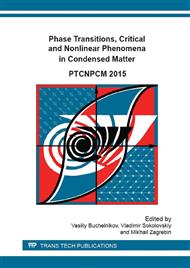[1]
K. Ito, W. Ito, R. Y. Umetsu, M. Nagasako, R. Kainuma, A. Fujita, K. Oikawa, K. Ishida. Martensitic Transformation in NiCoMnSn Metamagnetic Shape Memory Alloy Powders. Mat. Trans., 49 (2008) 1915-(1918).
DOI: 10.2320/matertrans.mrp2008126
Google Scholar
[2]
W. Ito, X. Xu, R. Y. Umetsu, T. Kanomata, K. Ishida, R. Kainuma. Concentration dependence of magnetic moment in Ni50-xCoxMn50-yZy (Z =In, Sn) Heusler alloys. App. Phys. Lett. 97 (2010) 242512.
DOI: 10.1063/1.3525168
Google Scholar
[3]
F. Chen, Y.X. Tong, X.L. Lu, B. Tian, L. Li, Y.F. Zheng. Martensitic Transformation and Shape Memory Effect of NiCoMnSn High Temperature Shape Memory Alloy. J Mater. Eng. Perform. 21 (2012) 2509-2514.
DOI: 10.1007/s11665-012-0371-4
Google Scholar
[4]
D.Y. Cong, S. Roth, L. Schultz. Magnetic properties and structural transformations in Ni-Co-Mn-Sn multifunctional alloys. Acta Mater. 60 (2012) 5335-5351.
DOI: 10.1016/j.actamat.2012.06.034
Google Scholar
[5]
F. Chen, Y.X. Tong, Y.J. Huang, B. Tian, L. Li, Y.F. Zheng. Suppression of g phase in Ni38Co12Mn41Sn9 alloy by melt spinning and its effect on martensitic transformation and magnetic properties. Intermetallics 36 (2013) 81-85.
DOI: 10.1016/j.intermet.2013.01.004
Google Scholar
[6]
A. Ghosh and K. Man. Large magnetoresistance associated with large inverse magnetocaloric effect in Ni-Co-Mn-Sn alloys. Eur. Phys. J. B 86 (2013) 378.
DOI: 10.1140/epjb/e2013-40489-0
Google Scholar
[7]
Z. Li, K. Xu, Y. L. Zhang, and C. Jing. Reproducible magnetostrain behavior induced by structure transformation for Ni46Co4Mn39Sn11 Heusler alloy. J. Appl. Phys. 117 (2015) 023902.
DOI: 10.1063/1.4905610
Google Scholar
[8]
M. Halder, M.D. Mukadam, K.G. Suresh, S.M. Yusuf. Electronic, structural, and magnetic properties of the quaternary Heusler alloy NiCoMnZ (Z = Al, Ge, and Sn). J. Magn. Magn. Mater. 377 (2015) 220-225.
DOI: 10.1016/j.jmmm.2014.10.107
Google Scholar
[9]
V.D. Buchel'nikov, A.N. Vasiliev, V.V. Koledov, S.V. Taskaev, V.V. Khovailo, V.G. Shavrov. Magnetic shape-memory alloys: phase transitions and functional properties Phys. Usp. 49 (2006) 871-877.
DOI: 10.1070/pu2006v049n08abeh006081
Google Scholar
[10]
P. Entel, M.E. Gruner, A. Dannenberg, M. Siewert, S.K. Nayak, H.C. Herper, and V. Buchelnikov. Fundamental aspects of magnetic shape memory alloys: Insights from ab initio and Monte Carlo studies. Mater. Sci. Forum 635 (2010) 3-12.
DOI: 10.4028/www.scientific.net/msf.635.3
Google Scholar
[11]
G. -H. Yu, Y. -L. Xu, Z. -H. Liu, H. -M. Qiu, Z. -Y. Zhu, X. -P. Huang, L. -Q. Pan. Recent progress in Heusler-type magnetic shape memory alloys. Rare Metals. 34 (2015) 527-539.
DOI: 10.1007/s12598-015-0534-1
Google Scholar
[12]
M. Khan, J. Jung, S.S. Stoyko, A. Mar, A. Quetz, T. Samanta, I. Dubenko, N. Ali, S. Stadler, and K.H. Chow. The Role of Ni-Mn Hybridization on the Martensitic Phase Transitions in Mn-rich Heusler Alloys. Appl, Phys. Lett., 100 (2012) 172403.
DOI: 10.1063/1.4705422
Google Scholar
[13]
M. Khan, J. Jung, S.S. Stoyko, A. Mar, A. Quetz, T. Samanta, I. Dubenko, N. Ali, S. Stadler, and K.H. Chow. Enhancement of Ferromagnetism by Cr Doping in Ni-Mn-Cr-Sb Heusler Alloys. Appl, Phys. Lett., 102 (2013) 112402.
DOI: 10.1063/1.4795627
Google Scholar
[14]
V.V. Sokolovskiy, P. Entel, V.D. Buchelnikov, and M. E. Gruner. Achieving large magnetocaloric effects in Co- and Cr-substituted Heusler alloys: Predictions from first-principles and Monte Carlo studies. Phys. Rev. B. 91(2015) 220409(R).
DOI: 10.1103/physrevb.91.220409
Google Scholar
[15]
H. Ebert, D. Kodderitzsch, and J. Minar. Calculating condensed matter properties using the KKR-Green's function method—recent developments and applications. Rep. Prog. Phys., 74 (2011) 096501.
DOI: 10.1088/0034-4885/74/9/096501
Google Scholar
[16]
J.P. Perdew, K. Burke, M. Ernzerhof. Generalized Gradient Approximation Made Simple. Phys. Rev. Lett. 77 (1997) 3865-3868.
DOI: 10.1103/physrevlett.77.3865
Google Scholar
[17]
A.I. Liechtenstein, M.I. Katsnelson, V.P. Antropov, and V.A. Gubanov. Local spin density functional approach to the theory of exchange interactions in ferromagnetic metals and alloys. J. Magn. Magn. Mater. 67 (1987) 65-74.
DOI: 10.1016/0304-8853(87)90721-9
Google Scholar


